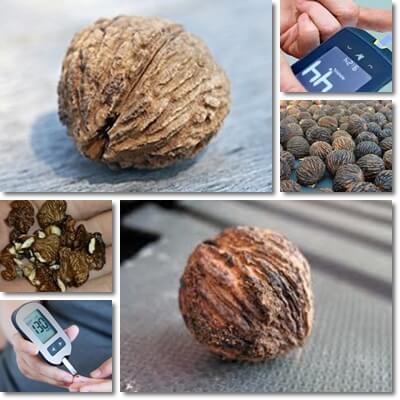Black walnuts are just as good for diabetics as regular walnuts, provided intake is limited to small amounts. If intake is excessive, they are just as bad for diabetics long-term as other foods high in fat and calories. And an excessive intake may mean eating too much at once (big servings) too often, or even smaller amounts but too frequently. If your condition is well managed and you enjoy healthy cholesterol levels and a healthy weight, then introducing small amounts of black walnuts into your diet can be a good thing. Anything from a few kernels to a handful can be considered a good serving size.
However, if you are struggling to maintain a healthy weight and are experiencing cardiovascular problems, then your healthcare professional might recommend adjusting your diet first and excluding problematic foods before introducing new foods, especially ones high in fat and calories such as black walnuts. Excess weight is a major source of complications for diabetes which is why it’s important to watch both what you are eating and how much of certain foods you are eating.

Diabetes and black walnuts nutritional value
With diabetes, the sugar, total carbohydrates, glycemic index, protein, fats content and energetic value of food matter a great deal, more so than vitamin and mineral content. Black walnuts have a nutritional profile that appeals to a diabetic diet if intake is limited and there is emphasis on clean eating and a balanced, varied, natural diet centered around meeting the individual nutritional requirements of the diabetic patient. The benefits of black walnuts for diabetics are rooted in their excellent nutritional value and include the following:
Benefits of black walnuts for diabetes
1) Slow down the absorption of sugar into the bloodstream
Black walnuts are high in protein, but also fat, which is a good thing because protein and fat take longer to digest and this helps slow down the digestion of carbohydrates and sugars as well and their absorption into the bloodstream in the form of simple sugars. So eating small amounts of black walnuts with a small serving of fruit or a vegetable salad helps prevent blood sugar spikes. A 1 oz serving of dried black walnuts further provides 1.9 g of dietary fiber. Dietary fiber further helps regulate digestion, nutrient absorption and maintain a healthy weight, all factors which contribute to benefits for diabetes.
2) Improve insulin sensitivity
Studies show that regular English walnuts have the ability to improve insulin sensitivity via their fatty acids profile, notably monounsaturated and polyunsaturated fatty acids, protein content, low sugar and carbohydrate, good fiber content as well as low glycemic index. And because the nutritional value and profile of bioactive elements in English walnuts resembles that of black walnuts, it has been suggested that black walnuts hold similar benefits when incorporated in a diabetic diet. Moreover, studies show black walnuts actually have a superior nutritional profile compared to English walnuts, especially when it comes to their antioxidant value and may thus be an even better choice in a diabetic diet.

3) Help with weight control
While black walnuts won’t help you lose much weight by themselves, because one food isn’t more important than the whole diet when it comes to losing weight, eating them in limited amounts can definitely help you maintain a steady weight. Black walnuts provide nutrition that is conducive to weight loss and weight management as well as help you filter out less healthy and downright unhealthy choices from your diet which could help you achieve a calorie deficit conducive to weight loss.
Despite being rich in fat and calories, the good fiber content of the black walnut regulates digestion, nutrient absorption, including the absorption of fats. And since it’s low in sugar and carbs, but high in protein, it is a better choice for weight management.
For one, protein helps build muscle mass and muscle tissue consumes more calories than fat tissue. Secondly, as they are low in sugar and carbs, but high in protein and fat, black walnuts are a low glycemic food which means they don’t spike blood sugar levels and curb cravings.
Fiber as well as the protein and fat in the kernels further help curb hunger, providing lengthy satiation and preventing overeating. Also, the fats themselves reduce cravings for heartier foods which can spark minor benefits for weight loss.
4) Benefits for the cardiovascular function
Black walnuts are a good source of dietary fiber and rich in healthy monounsaturated and polyunsaturated fatty acids (including Omega-3 and Omeg-6) which improve blood cholesterol profile by reducing LDL cholesterol levels and increasing HDL cholesterol levels. This holds benefits for preventing plaque buildup on the inside of artery walls and atherosclerosis disease. The good content of magnesium, potassium and vitamin B6 further favor cardiovascular health, helping improve blood pressure numbers (lower high blood pressure).
5) Low in carbohydrates and sugar
Another reason why diabetics can eat black walnuts in limited amounts with their condition is the low carbohydrate and low sugar content. Both carbohydrates (except fiber) and sugars are converted into simple sugars during digestion, then absorbed into the bloodstream, contributing to blood sugar levels. But because black walnuts are low in carbohydrates and sugar, they make a good choice for a diabetic diet.
6) Low glycemic index food with minimal effects on blood sugar
The glycemic index is a scale that measures how fast the sugars from a food are absorbed into the bloodstream. Below 55 is a low glycemic index. Between 55-69 is a medium glycemic index. Between 70-100 is a high glycemic index. Black walnuts have a low glycemic index, under 20. Some experts argue that the glycemic index score of black walnuts is practically 0.
This is because the walnuts are very low in sugar to begin with (some sources say they have no actual sugar), and low in simple carbohydrates, but a great source of indigestible carbs in the form of dietary fiber. With not that many carbs to fuel the rise in blood sugar, there is hardly one.
But it’s actually the high fat and protein content of black walnuts that makes them a very low glycemic food. Fat and protein in the kernels take longer to digest and delay the emptying of the stomach, also delaying absorption of sugar into the bloodstream. Eating black walnut kernels with other foods that are higher in simple digestible carbs slows down the absorption of sugar from the carbs in these other foods and makes the entire meal lower glycemic.
7) Other benefits of black walnuts for diabetes
- Benefits for wound healing and reduced infection risks thanks to zinc and Omega-3 fatty acids content.
- Benefits for skin thanks to fatty acids, vitamin E and B vitamins.
- Benefits for nervous system, including a certain degree of protection against nerve damage, a common complication of type 1 and type 2 diabetes (thanks to vitamin B6 and other B vitamins, but also the amino acids in protein and healthy fatty acids profile).
- Better blood pressure as a result of a good potassium, magnesium and vitamin B6 content.
- Healthier blood lipid profile, with lower LDL cholesterol and higher HDL cholesterol levels, all thanks to fatty acids like Omega-3 and Omega-6.
- Improved insulin sensitivity and blood sugar control from the low sugar, carbohydrate and high fat and protein content.
The nutritional profile of dried black walnuts
- Energetic value: 619 kcal/100 g
- Fat content: 59.33 g of fat, of which 15.4 are monounsaturated fats, 36.4 g of polyunsaturated fats (Omega-3, Omega-6, Omega-9) and 3.4 g of saturated fat, 0 g of cholesterol.
- Protein: 24.06 g
- Total carbohydrates: 9.58 g
- Sugars: 1.1 g
- Fiber: 6.8 g
- Net carbohydrates (carbohydrates other than fiber and sugars): 9.58 – 1.1 – 6.8 = 1.68 g
Vitamins and minerals content
- Vitamin B6: 0.583 mg/100 g (the recommended daily intake, RDI, for an average adult is 1.3-2 mg a day)
0.165 mg of vitamin B6/ oz (28.35 g) - Vitamin E: 2.08 mg/100 g (the RDI is 15 mg)
0.59 mg of vitamin E/ oz (28.35 g) - Magnesium: 201 mg/100 g (the RDI is 400 mg)
57 mg of magnesium/ oz (28.35 g) - Phosphorus: 513 mg/100 g (the RDI is between 700-1000 mg)
145 mg of phosphorus/ oz (28.35 g) - Potassium: 523 mg/100 g (the RDI is 4700 mg)
148 mg of potassium/ oz (28.35 g) - Zinc: 3.37 mg/100 g (the RDI is 11-15 mg)
0.96 mg of zinc / oz (28.35 g) - Trace amounts of vitamins B1, B2, B3, B5, B9, A, K, C, calcium, iron, sodium.
How can you eat black walnuts with diabetes safely?
Eat small amounts and no more than one serving a day
See your doctor or a dietitian expert in diabetic diets to learn how much black walnuts you can eat in a day and get a personalized eating plan.
Also see Can You Eat Walnuts With Diabetes?
Choose only raw black walnuts, whether fresh or dried
But remember that the dried kernels concentrate more of everything (calories, fats, protein, fiber, carbohydrates, vitamins and minerals), so adjust your intake according to your individual nutritional requirements and based on your level of physical activity. Absolutely avoid fried, roasted or glazed walnuts and nuts of any kind.
Pair a few black walnut kernels with higher glycemic foods such as fruit or morning oats
While you can eat black walnuts by themselves and they won’t raise blood sugar levels to unhealthy values, it’s even better to eat them when you’re having a serving of fruit or a vegetable salad. The fat and protein in the kernels will help stabilize the absorption of sugar from the fruits and vegetables.
Black walnuts are not a cure for diabetes
It’s important to remember that eating black walnuts doesn’t cure diabetes. Instead, a healthy diet, clean, varied, balanced, suited to your individual nutritional requirements and the requirements of your condition as well as keeping active are what help prevent, improve and even treat type 2 diabetes. It’s a group effort.
Potential side effects of black walnuts
The side effects of eating black walnuts in diabetes are primarily a result of an excessive intake. The nut variety is still rich in calories and fats and eating too much will cause an excess caloric and fat intake and translate into health problems over time, including:
- Weight gain.
- Unhealthy blood cholesterol levels.
- High blood pressure and cardiovascular disease.
- Poor insulin sensitivity.
- Complications of diabetes stemming from the weight gain: nerve damage, neuropathy, eye damage, kidney damage, skin ulcers with poor healing etc.
Contraindications
The biggest contraindication to eating black walnuts with diabetes is an allergic reaction to black or English walnuts. There are also concerns that the tannins and other bioactive elements in the nut variety may limit the absorption of medicines and affect their efficacy so ask your doctor how eating black walnut may interact with any medication you are currently taking and what you can do about it.
Also read Can You Eat Cherries With Diabetes?
Conclusion: Can diabetics eat black walnuts?
To answer the question, yes, diabetics can eat raw, fresh or dried, black walnuts in limited amounts, as part of an overall healthy, varied and balanced diet. Authors of study papers on the effects of English walnuts on diabetes say that black walnuts have about the same nutritional properties and a similar therapeutic action and benefits to English walnuts when incorporated into a diabetic diet. Ideally, only small amounts should be consumed, preferably not everyday and no more than one serving a day. To get more benefits for blood sugar levels, you can pair a few kernels with fruits or vegetables such as in salads.
